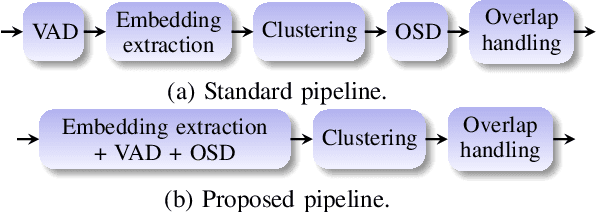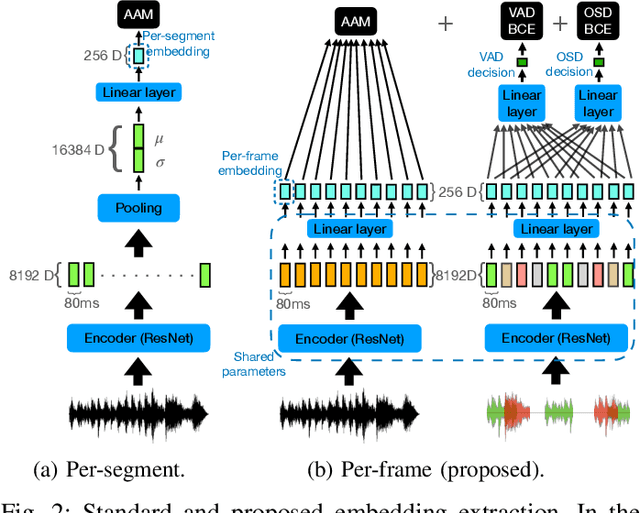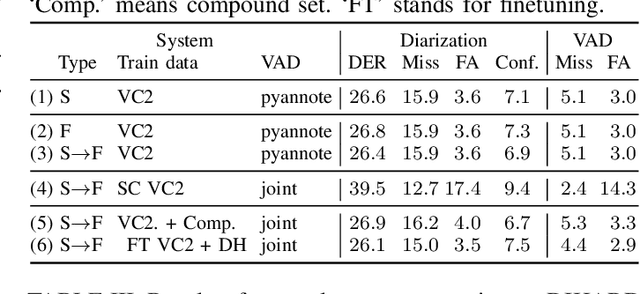Dominik Klement
DiCoW: Diarization-Conditioned Whisper for Target Speaker Automatic Speech Recognition
Dec 30, 2024Abstract:Speaker-attributed automatic speech recognition (ASR) in multi-speaker environments remains a significant challenge, particularly when systems conditioned on speaker embeddings fail to generalize to unseen speakers. In this work, we propose Diarization-Conditioned Whisper (DiCoW), a novel approach to target-speaker ASR that leverages speaker diarization outputs as conditioning information. DiCoW extends the pre-trained Whisper model by integrating diarization labels directly, eliminating reliance on speaker embeddings and reducing the need for extensive speaker-specific training data. Our method introduces frame-level diarization-dependent transformations (FDDT) and query-key biasing (QKb) techniques to refine the model's focus on target speakers while effectively handling overlapping speech. By leveraging diarization outputs as conditioning signals, DiCoW simplifies the workflow for multi-speaker ASR, improves generalization to unseen speakers and enables more reliable transcription in real-world multi-speaker recordings. Additionally, we explore the integration of a connectionist temporal classification (CTC) head to Whisper and demonstrate its ability to improve transcription efficiency through hybrid decoding. Notably, we show that our approach is not limited to Whisper; it also provides similar benefits when applied to the Branchformer model. We validate DiCoW on real-world datasets, including AMI and NOTSOFAR-1 from CHiME-8 challenge, as well as synthetic benchmarks such as Libri2Mix and LibriCSS, enabling direct comparisons with previous methods. Results demonstrate that DiCoW enhances the model's target-speaker ASR capabilities while maintaining Whisper's accuracy and robustness on single-speaker data.
Joint Training of Speaker Embedding Extractor, Speech and Overlap Detection for Diarization
Nov 04, 2024



Abstract:In spite of the popularity of end-to-end diarization systems nowadays, modular systems comprised of voice activity detection (VAD), speaker embedding extraction plus clustering, and overlapped speech detection (OSD) plus handling still attain competitive performance in many conditions. However, one of the main drawbacks of modular systems is the need to run (and train) different modules independently. In this work, we propose an approach to jointly train a model to produce speaker embeddings, VAD and OSD simultaneously and reach competitive performance at a fraction of the inference time of a standard approach. Furthermore, the joint inference leads to a simplified overall pipeline which brings us one step closer to a unified clustering-based method that can be trained end-to-end towards a diarization-specific objective.
Target Speaker ASR with Whisper
Sep 14, 2024Abstract:We propose a novel approach to enable the use of large, single speaker ASR models, such as Whisper, for target speaker ASR. The key insight of this method is that it is much easier to model relative differences among speakers by learning to condition on frame-level diarization outputs, than to learn the space of all speaker embeddings. We find that adding even a single bias term per diarization output type before the first transformer block can transform single speaker ASR models, into target speaker ASR models. Our target-speaker ASR model can be used for speaker attributed ASR by producing, in sequence, a transcript for each hypothesized speaker in a diarization output. This simplified model for speaker attributed ASR using only a single microphone outperforms cascades of speech separation and diarization by 11% absolute ORC-WER on the NOTSOFAR-1 dataset.
Discriminative Training of VBx Diarization
Oct 04, 2023


Abstract:Bayesian HMM clustering of x-vector sequences (VBx) has become a widely adopted diarization baseline model in publications and challenges. It uses an HMM to model speaker turns, a generatively trained probabilistic linear discriminant analysis (PLDA) for speaker distribution modeling, and Bayesian inference to estimate the assignment of x-vectors to speakers. This paper presents a new framework for updating the VBx parameters using discriminative training, which directly optimizes a predefined loss. We also propose a new loss that better correlates with the diarization error rate compared to binary cross-entropy $\unicode{x2013}$ the default choice for diarization end-to-end systems. Proof-of-concept results across three datasets (AMI, CALLHOME, and DIHARD II) demonstrate the method's capability of automatically finding hyperparameters, achieving comparable performance to those found by extensive grid search, which typically requires additional hyperparameter behavior knowledge. Moreover, we show that discriminative fine-tuning of PLDA can further improve the model's performance. We release the source code with this publication.
 Add to Chrome
Add to Chrome Add to Firefox
Add to Firefox Add to Edge
Add to Edge